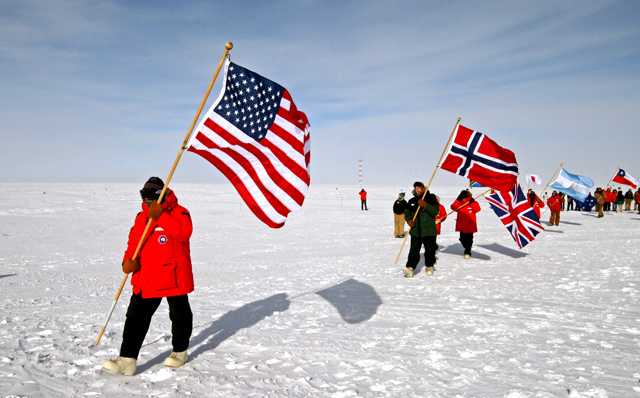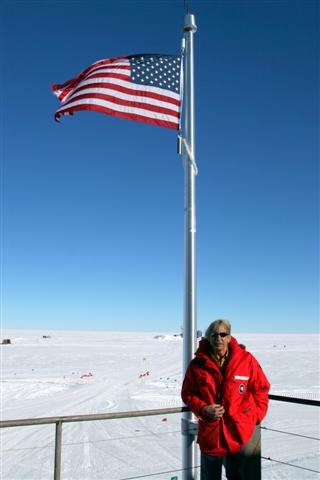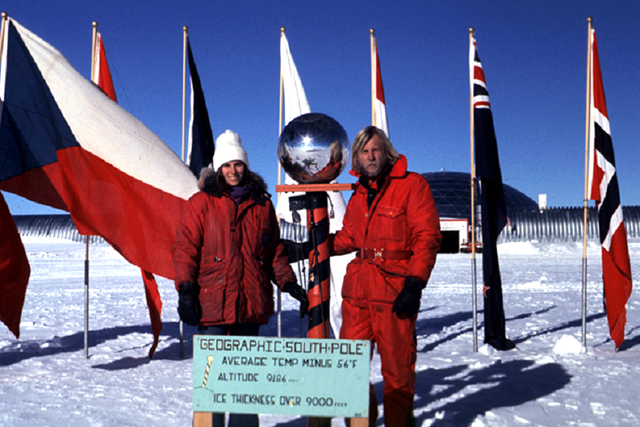|
'It's the people'Marty reflects on his 40-year passion for Antarctica and those who support the USAPPosted March 27, 2009
In 1994, after about 15 years away from the U.S. Antarctic Program (USAP) The National Science Foundation (NSF) The small collection of buildings under the geodesic dome built in the 1970s by the Navy Construction Battalions Marty didn’t hesitate when the job offer came his way. “I said, ‘When do we start?’” Fast-forward another 15 years of missed holidays and birthdays with family and friends. The 65,000-square-foot elevated research station, which sits atop a moving ice sheet on sturdy stilts to protect it from snowdrifts, is a modern marvel of engineering, construction and human perseverance in one of the world’s most hostile regions. Able to house about 150 people, and outfitted with state-of-the-art laboratories and communication systems, the elevated station today supports major experiments like the IceCube neutrino detector “I think the magnitude of the new station and the pressure that the project was under to achieve each of the … milestones in the summer season far exceeded anything that was done on the dome,” notes Marty, a few months away from retirement on June 30, reflecting on the accomplishment. The 62-year-old Wisconsin native and dedicated Green Bay Packers cheesehead should know. In 1969, as a recent college graduate, Marty took a job with the company Holmes and Narver, the first civilian contractor for what was then called the U.S. Antarctic Research Program. “I had always wanted to go to Antarctica,” Marty recalls. “I had always wanted to travel around the world. And always wanted to be involved in projects that you could travel the world and get paid for it.” Hired as a general field assistant — a job much like the low-rung, but highly sought-after general assistant (GA) positions of today in the Antarctic — Marty was assigned to work at Byrd Station. The job entailed everything from processing scientists and their cargo through the station to scooping snow into a snowmelter for water. “It was definitely the GA work of today,” Marty says, laughing. “It was, ‘Hey, you, get over here with a shovel.’” The Vietnam War was still going full blast in 1970 after Marty left the Ice. He joined the U.S. Army rather than being drafted, but shipped out to South Korea instead, and spent time in the demilitarized zone as an infantry Imjin Scout. Shortly before he left on his tour of duty, Marty met Elena, his future wife — whom he later convinced to join him on the Ice when he returned for the 1974-75 season. That was the final year of the new South Pole Station construction project of its day. The three-year construction effort was unprecedented in Antarctica, Marty notes. “Communications was state of the art then, too, with drawings dated 1969,” he says. “The planning and challenges of human beings putting all of the pieces together are similar,” Marty says of the two construction projects separated by time and technological advances. But one understands immediately that the second effort will somehow always mean more to Marty. Not just because of the magnitude of the accomplishment, the many sleepless nights and the 3 a.m. construction meetings to strategize a way to meet yet another deadline, but for the second family he adopted during all these years on the Ice. “It’s the people, the people, the people. That’s what I’ve loved about it,” he says unabashedly. “That’s what I always relate to is the work ethic, the esprit de corps, the camaraderie, and the attention to detail of the people who took on the challenges.” Doug “Dog” Forsythe, a senior construction coordinator for Raytheon Polar Services “We’re losing a good leader without having Jerry down there,” Forsythe said. “We all looked up to him.” Marty’s final deployment for the 2008-09 season was relatively short by his standards — less than two months. In some ways, though, it was the toughest because he knew this was it — an epilogue to a story begun 40 years earlier. The dread started early, during his medical physical, a requirement of anyone deploying to Antarctica for any length of time. “I didn’t want to do it, but it was for a different reason, because it was the last one,” he says. “On this last trip, I started to reflect on maybe I’ve taken this for granted. Maybe I haven’t stopped and reflected enough. This is it. The finality of it really started to hit.” On the Ice, a hyperawareness set in, as each day took him one closer to his departure date of Dec. 20. “Each day was looking around, talking to people, with the knowledge and recognition that this is one day closer to that finality of getting on that plane,” he says. “It’s been very emotional.” The day Marty got on that Air National Guard “He really did commit his life to building that station,” Watson says. “We lost our best advocate [for South Pole] … He was not only an advocate for the place, but for the people who cared about the Pole.” Marty says grief has transitioned to satisfaction as he’s had time to reflect. “Living the dream” seems a bit cliché, but for the son of a Wisconsin dairy farmer who has traveled the world pursuing his dreams, that platitude percolates with authentic meaning. “I actually have been able to do that,” he says. The day after his retirement, Marty and Elena plan to fly across the country to their family home in Long Beach, Calif., to begin a new chapter of their lives with their children and grandchildren. He jokingly says that he’s afraid he’ll “self-destruct in 32½ seconds” come July 1. “There will be no stress,” he muses. But what if Marty got another call from NSF some time in the future, needing his expertise to help with a new chapter in the history of South Pole? “My response would be, ‘When do we start?’” he says, though mindful of family commitments. “I will never, never be able to get 90 degrees south out of my blood,” he adds. “I’ve been really fortunate and blessed to be part of the U.S. Antarctic Program … and to be a part of a special team and a special group of people. You don’t get that opportunity very often in life.” |



For USAP Participants |
For The Public |
For Researchers and EducatorsContact UsU.S. National Science FoundationOffice of Polar Programs Geosciences Directorate 2415 Eisenhower Avenue, Suite W7100 Alexandria, VA 22314 Sign up for the NSF Office of Polar Programs newsletter and events. Feedback Form |




